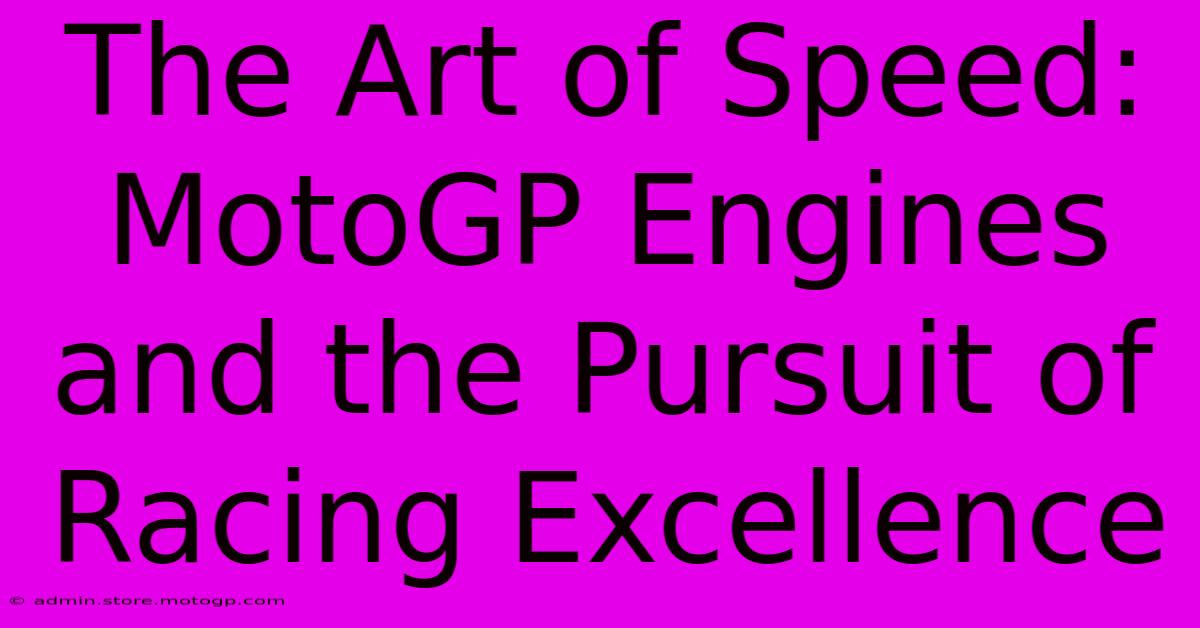The Art Of Speed: MotoGP Engines And The Pursuit Of Racing Excellence

Table of Contents
The Art of Speed: MotoGP Engines and the Pursuit of Racing Excellence
The roar of the engines, the blur of speed, the nail-biting competition – MotoGP embodies the pinnacle of motorcycle racing. But behind the spectacle lies a relentless pursuit of engineering perfection, a constant battle to extract every ounce of power and efficiency from the heart of these magnificent machines: their engines. This article delves into the fascinating world of MotoGP engines, exploring the technology, innovation, and unwavering dedication to pushing the boundaries of performance.
The Powerhouse: A Deep Dive into MotoGP Engine Technology
MotoGP engines are marvels of engineering, representing the cutting edge of internal combustion technology. These highly-tuned prototypes are typically four-stroke, 1000cc inline-four cylinder engines, meticulously designed for maximum power output and minimal weight. Let's break down the key components contributing to their unparalleled performance:
1. Sophisticated Cylinder Heads:
The cylinder heads are masterpieces of design, incorporating features like:
- Pneumatic valves: These advanced valve systems allow for incredibly precise control over valve timing and lift, maximizing airflow and combustion efficiency.
- Titanium components: Lightweight yet incredibly strong, titanium is extensively used in the construction of valves, connecting rods, and other crucial components, contributing significantly to the engine's overall power-to-weight ratio.
- High-flow intake and exhaust systems: Engineered to minimize restriction and maximize gas flow, these systems are critical for optimizing power delivery across the rev range.
2. Precision Crankshafts and Connecting Rods:
The crankshaft and connecting rods are subjected to immense forces at high RPM. Therefore, manufacturers utilize:
- High-strength steel alloys: Ensuring durability and reliability under extreme stress.
- Precise balancing: Minimizing vibrations for improved engine smoothness and performance.
3. Cutting-Edge Fuel Injection and Ignition Systems:
Modern MotoGP engines rely on sophisticated electronic control systems to manage fuel injection and ignition timing. This allows for:
- Precise fuel metering: Optimizing fuel delivery for peak power and efficiency at all engine speeds.
- Advanced ignition mapping: Ensuring optimal combustion under diverse track and weather conditions.
- Seamless throttle response: Providing riders with immediate and predictable power delivery.
The Pursuit of Excellence: Continuous Innovation in MotoGP Engines
The quest for improved performance in MotoGP is relentless. Teams and manufacturers constantly explore new technologies and techniques, including:
- Lightweight materials: The ongoing search for even lighter materials, such as carbon fiber and magnesium alloys, continues to drive weight reduction efforts.
- Aerodynamics: While not directly part of the engine, aerodynamic advancements significantly impact overall performance, allowing for better handling at high speeds.
- Data analysis and simulation: Sophisticated software and data acquisition systems play a crucial role in engine development, allowing engineers to analyze performance data and optimize engine settings.
Beyond the Engine: The Holistic Approach to Racing Success
While the engine is undoubtedly crucial, MotoGP success is not solely determined by engine power. Other factors play a critical role, including:
- Chassis and suspension: The chassis and suspension system must provide optimal handling and stability at high speeds.
- Rider skill and experience: Even the most powerful engine is useless without a skilled rider to control it.
- Team strategy and pit stops: Pit stop efficiency and strategic race decisions can significantly influence race outcomes.
In Conclusion:
The MotoGP engine is a testament to human ingenuity and the relentless pursuit of excellence. The complex interplay of engineering, technology, and skilled riders creates the thrilling spectacle we witness on the track. The continued innovation and development in this field ensure that the art of speed in MotoGP will continue to evolve, captivating audiences for years to come.

Thank you for visiting our website wich cover about The Art Of Speed: MotoGP Engines And The Pursuit Of Racing Excellence. We hope the information provided has been useful to you. Feel free to contact us if you have any questions or need further assistance. See you next time and dont miss to bookmark.
Featured Posts
-
Moto Gp Helmets For Sale Ride With The Best
Feb 20, 2025
-
F1 Parking Your Race Day Parking Sorted
Feb 20, 2025
-
Moto Gp Replicas For The Love Of Racing
Feb 20, 2025
-
Experience The Intensity Moto Gp Bike For Sale
Feb 20, 2025
-
Moto Gp Photoshoot An Inside Perspective
Feb 20, 2025
